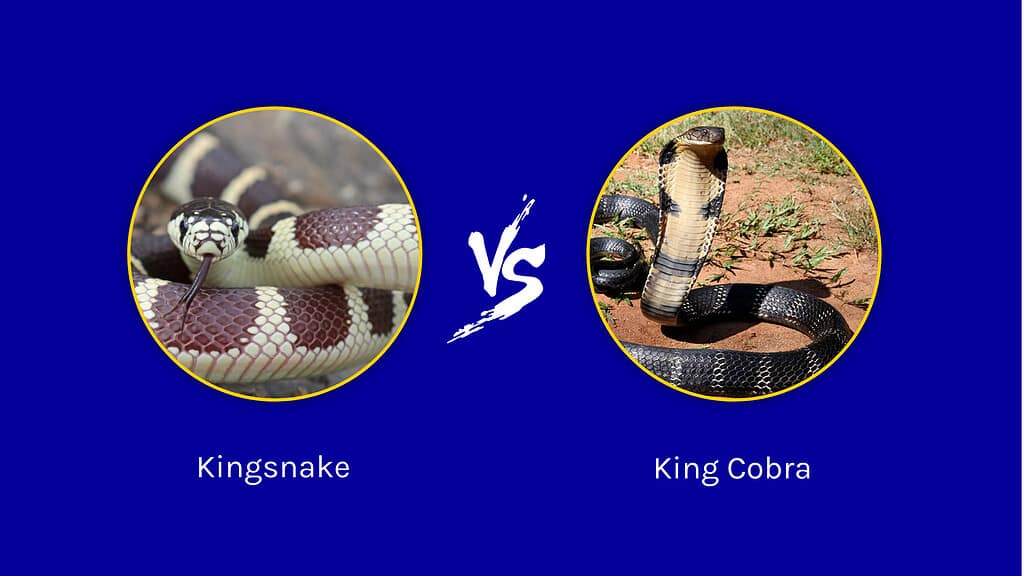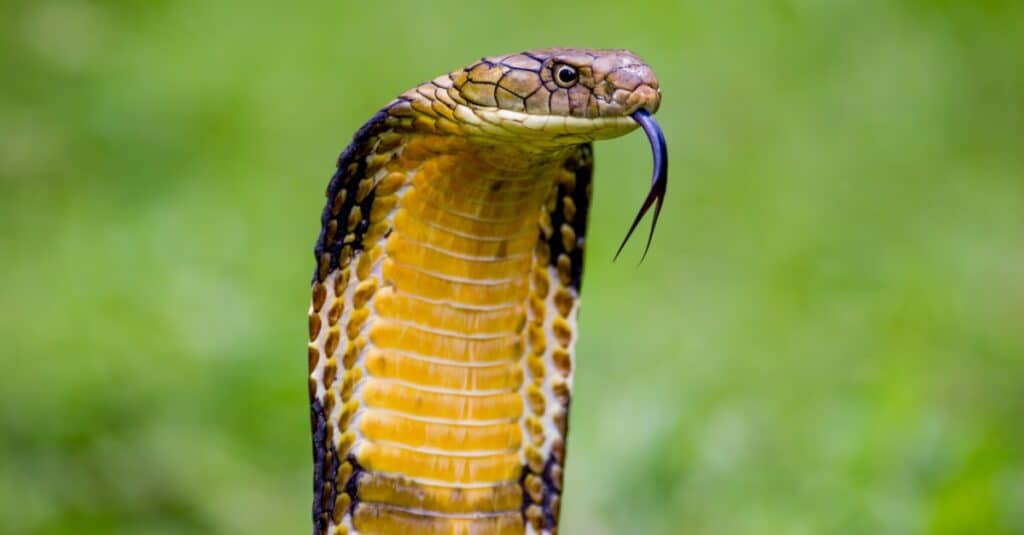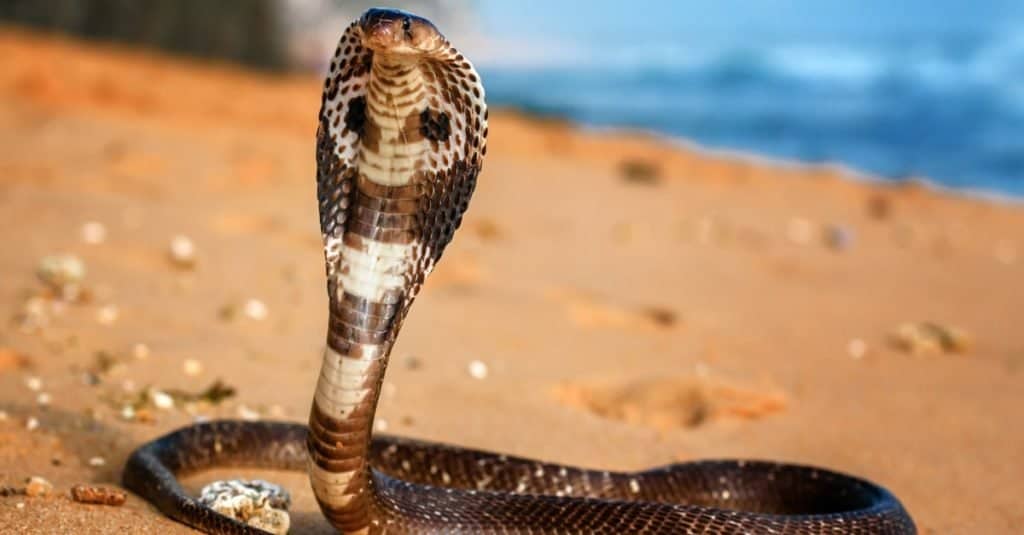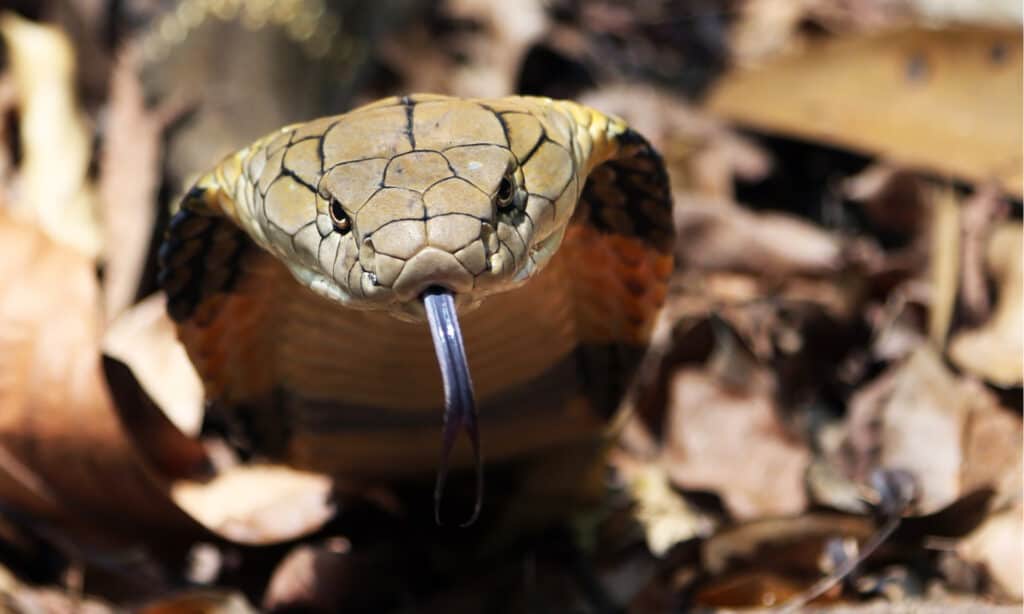The nomenclature around snakes can get very confusing. For example, the king cobra is not a true cobra since it’s not a member of the Naja genus. Also, many snakes have “King” in their name. We’re going to compare a kingsnake vs king cobra so that we can help clear the air of some confusion. By comparing and contrasting these snakes, you’ll be able to tell them apart very easily. We’ll even show you whether a kingsnake or a king cobra would win in a theoretical fight! With that in mind, let’s get into it!
Comparing Kingsnake vs King Cobra

| Kingsnake | King Cobra | |
|---|---|---|
| Size | Weight: 3.3lbs-5lbs Length: 2ft-5ft | Weight: 10lbs-15lbs Length: 10ft-19ft |
| Method of Attack | – Powerful constrictor – Strongest constrictors proportionate to body size of any snake | – Will lift up to a third of its body several feet from the ground and then strike, allowing it to deliver venom in the vital areas – 0.5in fangs – Long fangs deliver up to 1000mg of venom – A single bite can kill 11 humans |
| Venom Resistance | – Resistant to snake venom within its range | – Limited immunity to snake venom, but not immune to king cobras or other powerful venoms |
| Threat Display | – Coils and moves into an S-shape to attack – Resembles some venomous snakes in its range, like the coral snake | – Threat display that includes spreading a hood spread, a growling hiss, and drawing itself up several feet |
| Location | – North America and Mexico | – Southeast Asia |
| Colors | – Brown, yellow, red, black, and white – Significant banding patterns that make it look like other snakes, including venomous ones | – Black, yellow, green, and brown – No banding, just a solid color on top and a lighter color below |
The Key Differences Between a Kingsnake vs King Cobra

Some kingsnakes can resemble other deadly snakes, including coral snakes, while king cobras are distinct.
©Radiant Reptilia/Shutterstock.com
The greatest differences between a kingsnake and a king cobra include their location, size, and method of attack. The kingsnake is a reptile measuring up to 5ft long that is endemic to North America and uses constriction to kill its prey, and the king cobra is a reptile measuring up to 19ft long that is endemic to Southeast Asia that uses powerful venom to kill its foes.
The differences between these two animals are profound, but one thing they have in common is that they both prey on other snakes. These snakes’ preference for dining on other snakes is why they both have the term king in their names! We’re going to explore other points of comparison and show you why these snakes are so interesting.
Kingsnake vs King Cobra: Size
The kingsnake is much smaller than the king cobra. A king snake only measures between 3lbs and 5lbs, and they grow between 2ft and 5ft. That is much smaller than the king cobra that weighs up to 15lbs and grows up to 10ft to 13ft on average with a maximum of 19ft!

A king snake only measures between 3lbs and 5lbs, and they grow between 2ft and 5ft, while king cobras often exceed 19ft.
©iStock.com/takeo1775
Kingsnake vs King Cobra: Method of Attack
The kingsnake is a constrictor snake and the king cobra is a venomous snake. Although kingsnakes are relatively small, they manage to inflict a lot of constricting power on their foes relative to their size. Even though they are similarly sized to the rat snake, they’re far stronger. However, some kingsnakes will bite and thrash smaller snakes to death too.
The king cobra has some of the deadliest venom on the planet. A single bite from a king cobra is enough to kill 11 humans or to bring down an elephant. Not only is the snake’s venom powerful, but the king cobra is also an accomplished strategist. They raise their heads and up to a third of their body off the ground when preparing to strike in some cases.
That allows them to bite downward at enemies, including other snakes, and deliver a deadly dose of venom while they keep them under control with their fangs.
Kingsnake vs King Cobra: Venom Resistance

King snakes can resist venom of snakes in their own habitat, while king cobras have less resistance.
©Matt Jeppson/Shutterstock.com
The kingsnake is said to be immune to snake venom, but that only holds true for snakes that live in their range. For example, they can survive a bite from a rattlesnake, but that venom is very different from other snakes around the world.
The king cobra is a highly venomous snake that also has some limited resistance to snake venom, but only within their region and only to a certain point. After all, they share a range with some of the most venomous snakes in the world, including the Big Four which kill over 50,000 people a year.
Although both snakes have some limited venom resistance, they are far from immune to all venoms in the world.
Kingsnake vs King Cobra: Threat Display

The king cobra’s threat display is iconic and instantly recognizable, while the kingsnake does not have a hood.
©Vova Shevchuk/Shutterstock.com
The king snake’s threat response is similar to many other snakes. They will often draw themselves into a horizontal S-shape to get ready to attack. Some species of kingsnakes will also move their tail rapidly to make it seem like they are a rattlesnake!
King cobras have a much more powerful threat display. They will draw up to a third of their body off the ground, spread their hood, and use a growling hiss to frighten enemies. When they decide to strike, they are in a great position to do so since they can land a bite anywhere on their prey’s body.
Kingsnake vs King Cobra: Location
The kingsnake is endemic to North America, Central America, and the northern sections of South America. They are common sights, and people appreciate them for eating venomous snakes.
King cobras live in several countries in Southeast Asia. Although they are often believed to live only in India, they can be found as far away as the Philippines, Malaysia, China, and more.
Kingsnake vs King Cobra: Color
King cobras have a solid color on top of their body and a lighter color underneath. They can be black, yellow, green, or brown. Kingsnakes can be brown, yellow, red, black, and white, and they may often resemble other banded snakes. They sometimes look like coral snakes, something that works to their benefit when faced with other predators. However, the similarity can also get them killed by humans.
Kingsnake vs King Cobra: Who Would Win in a Fight?

The king cobra has the advantage of its venom and skill fighting other snakes to help it win the battle against the kingsnake.
©Suresh Suryasree/Shutterstock.com
A king cobra would win a fight against a kingsnake. The king cobra has the size, venom, and experience of killing other snakes to decisively end this fight. Although the kingsnake has some venom immunity, it does not have immunity to king cobra venom.
The king cobra would use its ability to bite downward at the kingsnake to quickly envenomate it and hold the smaller snake in place while the venom took effect. It would not take long for this battle to be over. The king cobra’s constriction would not be enough to kill the much larger snake in time to save its own life.
The photo featured at the top of this post is © Joe Farah/Shutterstock.com
Discover the "Monster" Snake 5X Bigger than an Anaconda
Every day A-Z Animals sends out some of the most incredible facts in the world from our free newsletter. Want to discover the 10 most beautiful snakes in the world, a "snake island" where you're never more than 3 feet from danger, or a "monster" snake 5X larger than an anaconda? Then sign up right now and you'll start receiving our daily newsletter absolutely free.
Thank you for reading! Have some feedback for us? Contact the AZ Animals editorial team.






